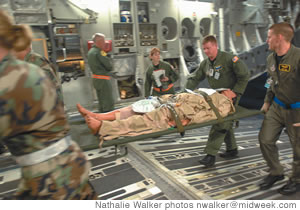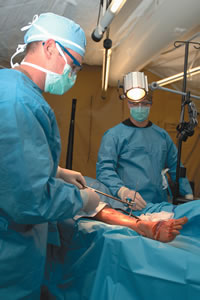IN CASE OF EMERGENCY
On a recent weekday, the tiny Pacific Island nation of Moku was struck by a super typhoon that left 2,000 dead, 2,000 more in need of medical attention and more than 50,000 homeless. Fortunately for the residents, airmen from bases in Guam, Hawaii, Alaska, Texas and Washington were on the ground within 24 hours to begin providing emergency medical care to the storm-battered island.

By .(JavaScript must be enabled to view this email address)
E-mail this story | Print this page | Archive | RSS

|
On a recent weekday, the tiny Pacific Island nation of Moku was struck by a super typhoon that left 2,000 dead, 2,000 more in need of medical attention and more than 50,000 homeless.
Fortunately for the residents, airmen from bases in Guam, Hawaii, Alaska, Texas and Washington were on the ground within 24 hours to begin providing emergency medical care to the storm-battered island.
Three days later on what had been a flat, rocky field stood a modern medical facility that included emergency and operating rooms, an intensive care unit, a 10-bed ward and the capability to provide pediatric, obstetrics/gynecology, radiology, dental and other services.
The 10 doctors and 236 support personnel delivered 10 babies, processed 32 fatalities, air evacuated 94 patients and provided mental health care to the residents.
In addition to the mass of blunt trauma, broken bones, dehydration and malnutrition was the need to provide immunization for malaria and typhus while containing communicable diseases by providing fresh water. A public education effort also was begun to inform the island’s residents about hygiene and how to install preventative steps to contain the further spread of disease. With much of the island’s infrastructure destroyed, most of the food, equipment and power had to be flown in.
While the island of Moku and the circumstances surrounding the devastation were make-believe, the factual basis was hardly fictitious. The South Pacific has been battered in recent years by typhoons, earthquakes, volcanoes and tsunamis that have left hundreds of thousands dead, sick and homeless, and in need of quick, expert care.
Called Operation Pacific Lifeline 2008, the exercise that was more than a year in the making got its first chance to put theory to practice at the Kona International Airport.

|
Although the Air Force has been providing help in such situations for years, Operation Pacific Lifeline was a first because at no time has the service been able to provide such in-depth response in such a short period of time.
Col. Kevin Kersh, the operation’s commanding officer, called the exercise unique because “the capability of Air Force has not been used in the theater” and because of the number of bases involved. He also said it would not be too long before the lessons learned in the $1.9 million exercise would be put to actual use somewhere in the massive region that encompasses 60 percent of Earth’s population, spread across 41 nations and nearly half of the world’s surface.
“The series of large scale disasters in the Pacific - tsunamis, earth quakes, mud slides - are likely to continue,” he said. “The ability to rapid-response is critical to save lives.”
Born from a request by the State Department in the spring of 2006 to provide emergency response to a natural crisis anywhere on the globe, the idea moved through the Pentagon planning process all the way to the White House.

|
“Nobody has tasked us to do humanitarian aid,” said Maj. Ray Fielder, a Pentagon observer and representative for the Air Force Surgeon General. “We go out and do certain humanitarian missions, like in South America, for example, but never before have we put it together as a package that the State Department could ask for and be ready to deploy in a reasonable amount of time, in 24 hours or less. Before it would take us three or four days to get in motion.”
And when thousands are displaced and in need of medical care, minutes count. Officially titled the Humanitarian Relief Operations Operational Capability Package, it assembled special teams located throughout the world to move quickly. For the Pacific region, much of that quick turn-around help will come from the 36th Contingency Response Group at Andersen Air Force Base, Guam.
“The 36th CRG has the capability to immediately assess, open, establish and operate an air base,” said Maj. Troy Roberts, commander of the 736th Security Forces Squadron at Andersen. “Our strength is that we are a self-contained unit with airmen in more than 30 specialties who can deploy within 12 hours of notice.”
In less than 36 hours, the unit deployed more than 85 airmen who set up base operations that included security, airfield management, water and power production, food services and accommodations for 300.
Among the first on the scene was Capt. Jeremy Oldham, a civil engineer.
His job is to determine if the area can physically support the mass of people and equipment required to provide the needed care. That means not only having landing areas large enough to sup-
Page 1 of 2 pages for this story 1 2 >
E-mail this story | Print this page | Comments (0) | Archive | RSS
Most Recent Comment(s):








